FSC and PEFC are leading certification systems that verify sustainable, responsible sourcing of paper products. FSC emphasizes detailed environmental, social, and economic standards with thorough audits, while PEFC relies on national standards and streamlined processes. Both promote responsible forestry, community engagement, and transparency, helping you identify eco-friendly options through labels. Understanding their differences can guide your choices and support sustainability efforts—keep exploring to learn more about these important labels.
Key Takeaways
- FSC emphasizes comprehensive environmental, social, and economic standards with multi-stage third-party audits, while PEFC relies on national standards and mutual recognition.
- FSC certification focuses on protecting indigenous rights, biodiversity, and community livelihoods through detailed assessments; PEFC balances ecological, social, and economic interests.
- Both standards require chain of custody verification, but FSC audits are typically more detailed and rigorous than PEFC’s streamlined process.
- FSC labels signal adherence to strict sustainability criteria, whereas PEFC emphasizes traceability and responsible sourcing through its chain of custody standards.
- Recognizing certification involves checking for official logos and sourcing details, supporting responsible forestry and eco-friendly consumer choices.
What Are FSC and PEFC Certifications?
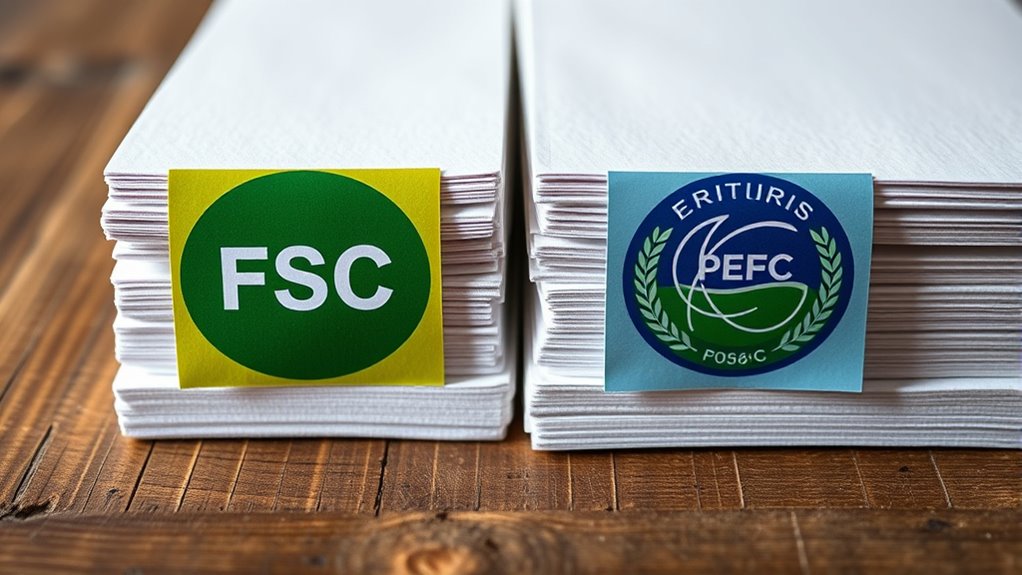
Have you ever wondered what makes paper environmentally friendly? FSC and PEFC certifications are key indicators. These eco labels signify that the paper comes from sustainably managed forests, ensuring responsible harvesting. Both organizations promote recycling programs, encouraging the reuse of paper and reducing waste. The eco label significance lies in their rigorous standards, which verify that the wood fibers are sourced ethically and environmentally sound. When you see these certifications, you’re assured that the product supports forest conservation and minimizes ecological impact. They help consumers make informed choices, fostering sustainability. By choosing FSC or PEFC certified paper, you’re supporting responsible forestry practices and contributing to environmental preservation. These labels serve as trusted symbols of commitment to ecological integrity and social responsibility. Incorporating sustainable practices into manufacturing further enhances the positive environmental impact of certified paper products. Understanding the forest management standards behind these labels can deepen your appreciation for their role in conservation efforts.
The Standards Behind FSC Certification
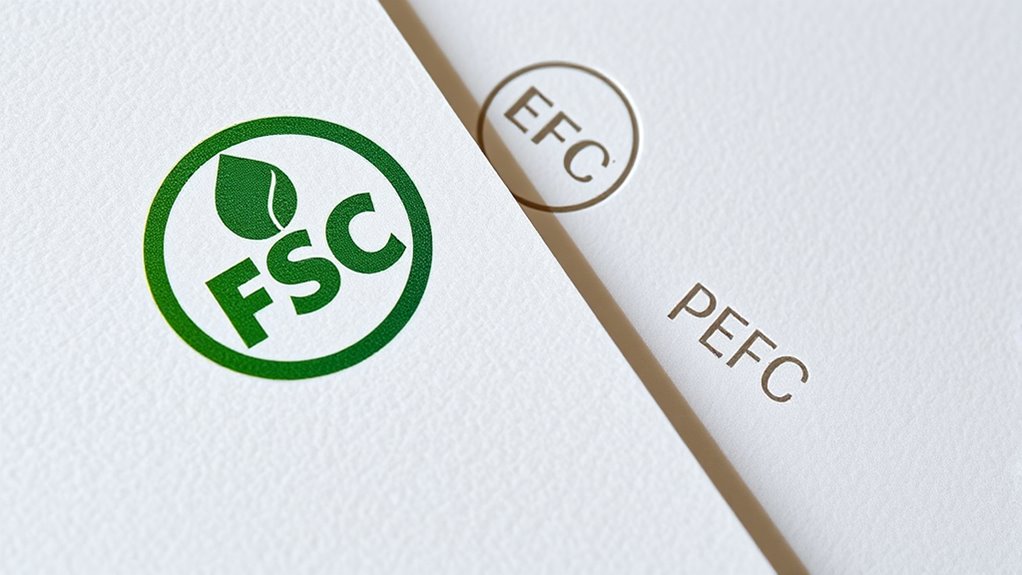
You’ll want to understand the certification criteria that FSC sets to guarantee responsible forest management. These standards cover environmental, social, and economic aspects, making sure forests are protected and communities are supported. Independent audits verify compliance, so you can trust that certified products meet these rigorous requirements. Considering regional resources and tools can help ensure compliance and understanding of local forest management practices. Additionally, diverse design options in certified paper products can reflect sustainable choices for various uses. Incorporating Pimple Patch principles of targeted treatment and responsible sourcing can further enhance sustainable and effective consumption choices. Understanding signs of spoilage in paper products, such as mold or discoloration, can also aid in maintaining quality and sustainability.
Certification Criteria Overview
The standards behind FSC certification establish a rigorous framework to guarantee responsible forest management. They focus on sustainable practices such as reforestation, maintaining biodiversity, and respecting indigenous rights. To assure ongoing credibility, certification validity requires regular audits and compliance checks. These criteria set clear benchmarks for forest stewardship, emphasizing reforestation practices that replenish harvested areas. The certification process demands evidence of sustainable harvesting, strict environmental controls, and social responsibility. This comprehensive approach ensures that certified forests meet high standards over time, reinforcing trust in the label. Additionally, social safeguards are integral to the standards, ensuring that local communities’ rights and livelihoods are protected throughout the certification process. Moreover, the standards include provisions for continuous improvement, encouraging ongoing enhancements in forest management practices. Furthermore, integrating innovative technologies can enhance the transparency and effectiveness of certification processes, promoting greater accountability and trust among stakeholders.
Independent Auditing Processes
Independent audits are the backbone of FSC certification, ensuring that forest management practices remain responsible and compliant over time. During these audits, independent verification is conducted through thorough audit procedures to assess adherence to FSC standards. You’ll find that auditors review documentation, inspect forest sites, and interview staff to verify sustainable practices. These processes are scheduled regularly, often annually, to maintain accountability. The audit procedures are designed to identify any non-compliance and recommend corrective actions. By relying on independent verification, FSC guarantees transparency and integrity in its certification system. This rigorous auditing process reassures consumers that certified products come from responsibly managed forests, reinforcing FSC’s commitment to sustainability and forest conservation.
The Standards Behind PEFC Certification
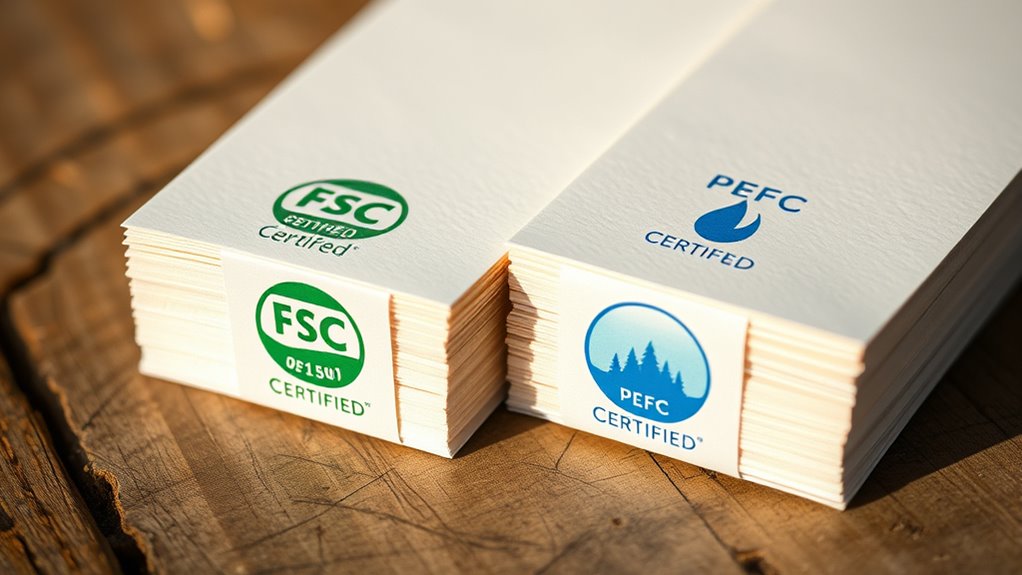
You should understand that PEFC certification relies on strict forest management criteria to guarantee sustainable practices. Additionally, its chain of custody standards track certified materials through every stage of production. These points are key to recognizing how PEFC maintains credibility and environmental responsibility. Implementing chain of custody standards helps ensure transparency and accountability throughout the supply chain. Moreover, adherence to forest management criteria ensures that forests are managed responsibly, balancing ecological, social, and economic interests. Incorporating sustainable forestry practices further reinforces the commitment to long-term environmental stewardship.
Forest Management Criteria
PEFC certification relies on strict forest management criteria that guarantee sustainable and responsible practices. These standards ensure forests are managed with care for reforestation initiatives and biodiversity preservation. You can expect that logging is controlled, and areas are replanted promptly. Effective management strategies promote maintaining natural habitats and protecting endangered species. Incorporating continuous improvement practices helps adapt standards to emerging environmental challenges, ensuring ongoing sustainability. Additionally, embracing failure in creativity can lead to innovative approaches in implementing these standards effectively.
Chain of Custody Standards
Chain of Custody standards form the backbone of PEFC certification by ensuring that every step in the supply chain is transparent and accountable. These standards require you to implement robust traceability systems, allowing you to track certified material from forest to final product. By doing so, you guarantee supply chain transparency, giving consumers confidence in the paper’s origin. You must document each transfer and transformation process, maintaining clear records that verify compliance with PEFC requirements. This process prevents mixing certified and non-certified materials, ensuring integrity throughout production. Ultimately, these standards help you demonstrate responsible sourcing, foster trust with customers, and uphold sustainability principles. With strict traceability systems in place, PEFC certification assures that every stakeholder in your supply chain values transparency and accountability. Incorporating effective juice extraction methods and technology can also improve traceability and quality control in the supply chain. Additionally, implementing advanced supply chain management tools can streamline the tracking process and enhance overall efficiency. Maintaining a comprehensive chain of custody record is essential for verifying compliance and supporting sustainable practices across your supply chain. Reliable storage methods, such as proper packaging and climate control, also help maintain product integrity and traceability throughout the process. Employing digital tracking systems can further enhance the accuracy and ease of maintaining these records, ensuring ongoing compliance.
Key Differences in Certification Processes
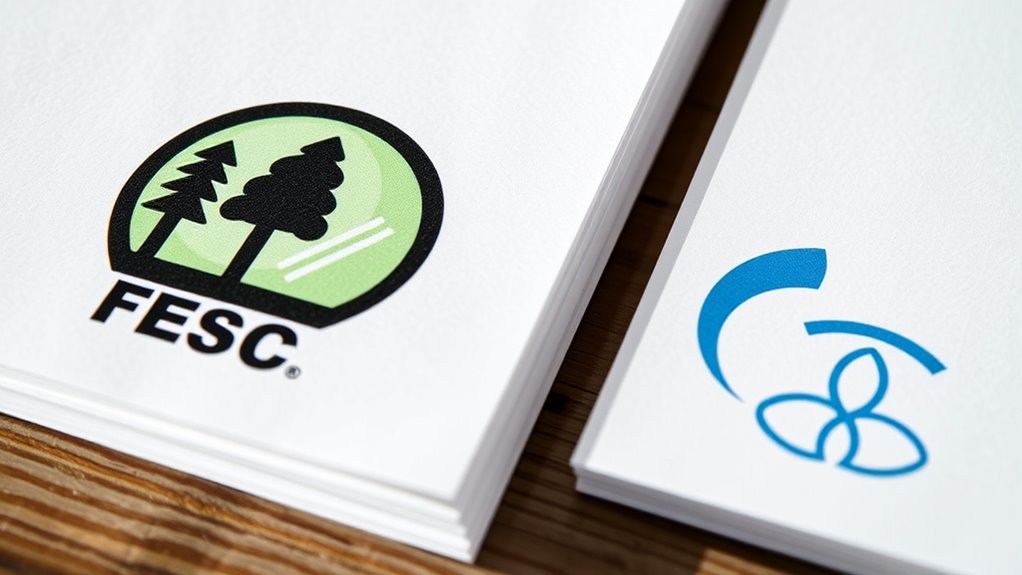
While both FSC and PEFC certification processes aim to verify responsible forestry practices, they differ markedly in their procedures. The FSC emphasizes a thorough sustainability assessment, which includes social, environmental, and economic factors, ensuring a detailed review before certification. PEFC’s process focuses on streamlining certification validity through mutual recognition agreements with national schemes, promoting consistency across countries. FSC audits are often more detailed, involving multiple stages and third-party evaluations, whereas PEFC relies heavily on national standards aligned with international benchmarks. Both organizations require annual surveillance audits to maintain certification, but the depth and scope of these assessments can vary. Additionally, the certification scope can influence the selection, with FSC often offering more comprehensive evaluations of forest management practices. Your choice may depend on whether you prioritize a rigorous sustainability assessment or a certification process aligned with national standards for broader recognition.
Environmental and Social Criteria
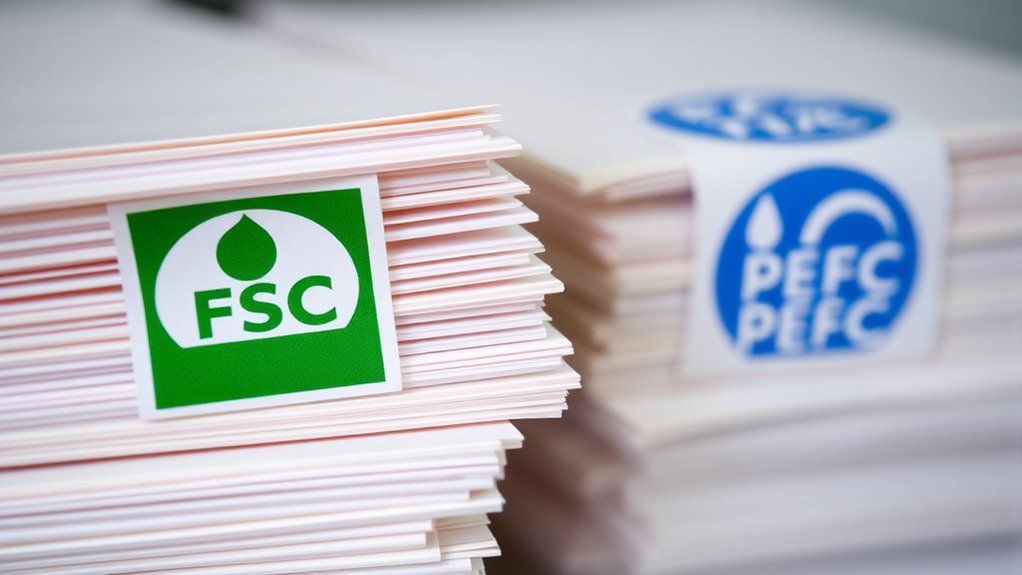
Have you ever wondered how certification standards address environmental and social impacts? Both FSC and PEFC focus on these areas to promote sustainability. Here’s how they do it:
Certification standards like FSC and PEFC promote sustainability by emphasizing responsible forestry, community involvement, and workers’ rights.
- They require responsible forestry practices that prioritize biodiversity conservation, ensuring ecosystems stay healthy.
- They emphasize community engagement, meaning local communities have a say in forest management and benefit from the resources.
- They set social criteria that protect workers’ rights, promote fair wages, and prevent exploitation.
Implications for Consumers and Businesses
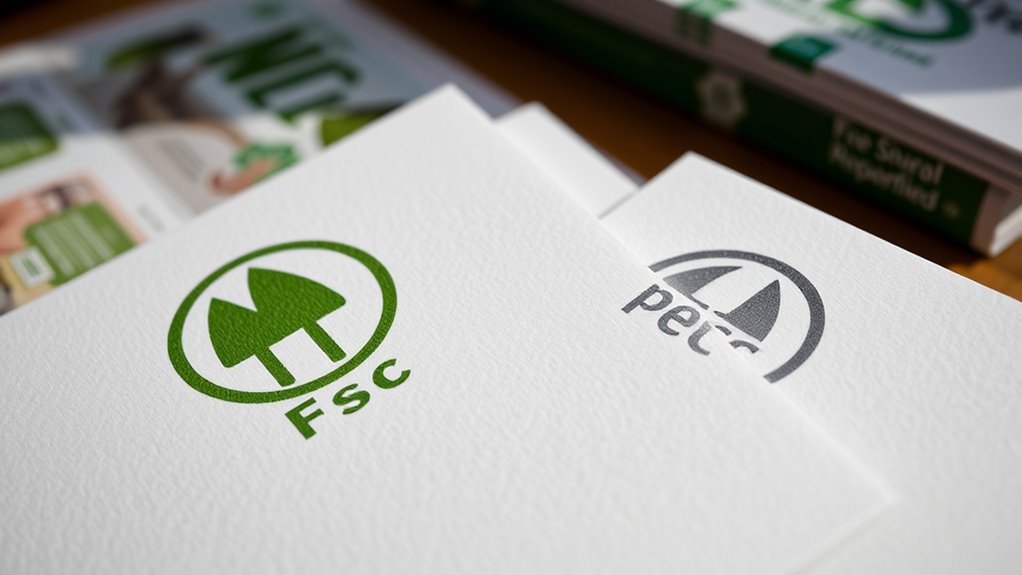
Choosing FSC or PEFC certified paper can substantially impact your purchasing decisions and business practices. It influences how you approach paper sourcing, ensuring you support sustainable forest management. For consumers, heightened awareness about certification labels helps make eco-friendly choices, aligning purchases with environmental values. Businesses benefit by demonstrating corporate responsibility, appealing to eco-conscious clients, and meeting sustainability standards. Using certified paper can also enhance brand reputation and satisfy regulatory requirements. Being informed about these labels encourages responsible consumption and ethical sourcing, ultimately reducing environmental impact. Additionally, understanding the implications helps you evaluate suppliers and products more effectively, ensuring your choices promote sustainability. In a competitive market, this awareness can set you apart, reinforcing a commitment to environmental stewardship and responsible business practices.
How to Identify Certified Paper Products
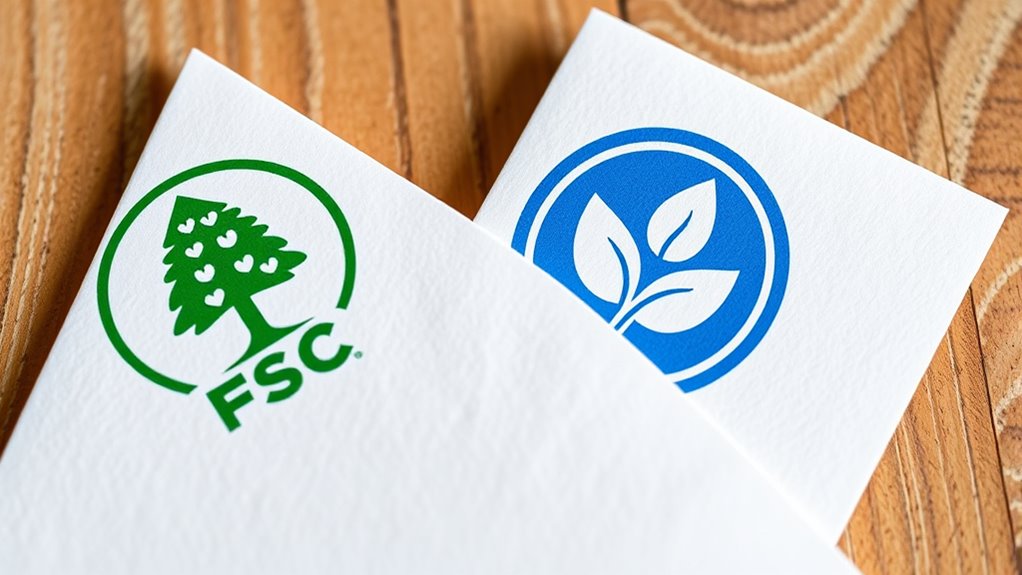
Identifying certified paper products starts with carefully examining labels and documentation. First, look for clear certification logos from organizations like FSC or PEFC. These logos confirm the paper’s sustainability claims. Second, review the paper sourcing details; certified products often specify responsible sourcing practices, ensuring sustainable paper sourcing. Third, check for information about recycling practices, such as whether the paper is made from recycled material or supports recycling initiatives. By paying attention to these details, you can confidently select products that meet your sustainability standards. Remember, genuine certification labels are your best assurance that the paper aligns with environmental goals and responsible sourcing. Being vigilant helps promote sustainable practices and supports companies committed to environmental stewardship.
The Influence of Certification on Sustainability Goals

Certification plays a crucial role in advancing sustainability goals by guaranteeing that paper products meet strict environmental standards. It promotes responsible sourcing and encourages companies to adopt eco-friendly practices. Your commitment to certified paper supports recycling initiatives and demonstrates corporate responsibility. Certifications like FSC and PEFC motivate organizations to reduce waste, improve forest management, and prioritize sustainable supply chains. They also influence consumer behavior, pushing businesses to align with environmental values. The table below shows how certification impacts various sustainability aspects:
| Aspect | Certification Impact |
|---|---|
| Recycling Initiatives | Promotes use of recycled fibers |
| Forest Management | Ensures sustainable harvesting |
| Supply Chain Transparency | Increases accountability |
| Corporate Responsibility | Demonstrates environmental commitment |
| Consumer Trust | Builds confidence in eco-labels |
Making Informed Choices for Responsible Consumption
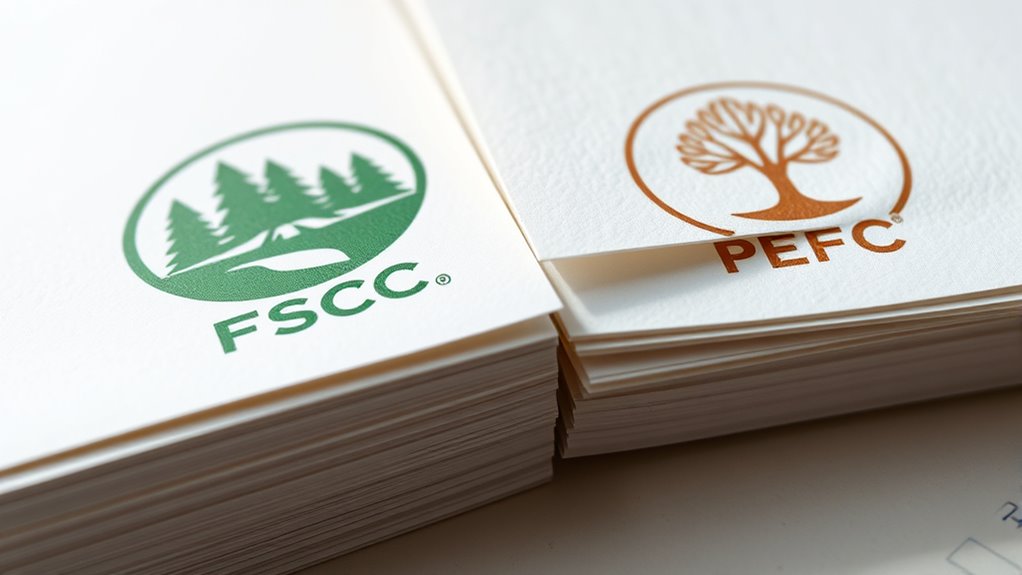
To make responsible choices when purchasing paper products, you need to understand the significance of certification labels like FSC and PEFC. These labels ensure products come from sustainably managed forests, supporting eco-friendly practices. When selecting paper, consider these factors:
Choosing FSC or PEFC certified paper supports eco-friendly, sustainable forest management.
- Check if the packaging materials are recyclable or made from recycled content to reduce waste.
- Look for certifications that emphasize responsible recycling practices, ensuring minimal environmental impact.
- Prioritize products with clear labels indicating sustainable sourcing, which encourages responsible consumption.
Frequently Asked Questions
How Do FSC and PEFC Certifications Impact Paper Pricing?
You might notice FSC and PEFC certifications can impact paper pricing. These certifications often lead to higher costs because they encourage sustainable harvesting, which can be more expensive due to stricter standards. Your purchasing decisions influence recycling rates and the supply chain, as certified paper guarantees responsible sourcing. While prices may be higher, you’re supporting environmentally friendly practices that promote sustainability and long-term resource availability.
Are There Regional Preferences for FSC or PEFC Certification?
You might think regional preferences for FSC or PEFC certification don’t matter, but cultural influences often shape these choices. In some areas, FSC is preferred due to its strong environmental reputation, while others favor PEFC for its focus on local forest management. Recognizing these regional preferences helps you select the right certification, ensuring your paper aligns with local values and supports sustainable practices tailored to that region’s cultural context.
Can Paper Be Certified Under Both FSC and PEFC Simultaneously?
Yes, paper can be dual certified under both FSC and PEFC, showing a commitment to sustainability. This dual certification enhances your confidence in the paper’s environmental impact, as it meets the standards of two respected organizations. By choosing dual-certified paper, you’re supporting responsible forestry practices and reducing your carbon footprint. It’s a smart choice for eco-conscious consumers who want to maximize their positive environmental impact.
How Do Certification Bodies Verify Compliance During Audits?
Ever wonder how certification bodies guarantee compliance? During audits, they follow strict audit procedures to verify adherence to established compliance standards. They review documentation, trace the origin of raw materials, and assess operational practices. Do you think these steps are enough to guarantee sustainability? These procedures help confirm that organizations meet environmental, social, and economic criteria, ensuring the integrity of the certification and maintaining trust in the sustainability labels you rely on.
What Are the Future Trends for Sustainability Labels in Paper Industry?
You should expect sustainability labels in the paper industry to evolve with digital tracking, enhancing transparency and trust. As consumer awareness grows, companies will likely adopt more sophisticated labels that verify eco-friendly practices in real-time. This shift aims to meet increasing demand for responsible sourcing, making it easier for you to identify genuinely sustainable products. Future trends will focus on integrating technology to provide clearer, more reliable information at your fingertips.
Conclusion
Choosing FSC or PEFC certified paper gently guides you toward a more sustainable future. By paying attention to these labels, you embrace a quiet act of care for the environment and communities. Your conscious choice becomes a subtle yet powerful gesture, supporting responsible forestry and ethical practices. Together, these small steps nurture hope and harmony, making it easier to weave sustainability into your everyday life without feeling overwhelmed.










